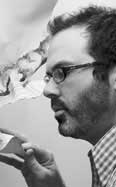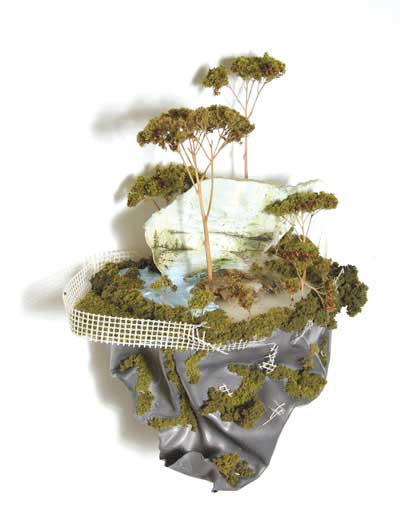

'Torn from the making of knowing's vista,' 2010, Acrylic, foam, lead, moss, paper, pencil, sedum, sponge, wax in acrylic box frame
20' x 15' x 9'
Growing up in Wisconsin, Gregory Euclide didn't visit museums or art galleries. Instead, he went on long walks in the woods with his father. 'We would walk, my father in front and me behind. He would stop and listen. So I would stop, wondering, why did he stop? I would listen, but I didn't know what I was listening for. Then, as he would begin to walk again, I would ask him why did we stop, and he would say: 'I thought I heard an owl.''
For Euclide nature, contemplation and curiosity are concomitant. Today he walks in Minnesota near the Twin Cities, observing and collecting found objects, interesting plant material, all of which are incorporated into his art--multi-dimensional objects made from crumpled paper, on which might be elaborate and detailed drawings or paintings. He then adds organic material like moss, and inorganic items like weathered Styrofoam. He describes his work as baroque; it is. He includes in his sculptural objects things that are typically overlooked: things his father taught him to see and hear--human actions and reactions to the land. Take for example the Capture series, where he pours paint and liquid adhesive from a can that when solidified captures dirt, plants, and whatever happens to be on the ground. In Denver, he did a large capture piece with a 55 gallon drum taken from Clear Creek Canyon, a nearby tourist destination, and displayed it at David B. Smith gallery with a life-sized guardrail representing a scenic pull-off. The viewer stands and looks at this idealized slice of land, its fake trees and moss, the cigarette butts littering the gravel covered floor. '[But] we don't consider the road we drove on to get to this place to see the scenic view, that we just ripped apart a mountain to get here in a car,' Euclide says. 'In a car you don't have to experience nature. We think we've overcome nature. It's a fool's way
of looking at things.'
Euclide is perspicacious; his work a cogitation between the artifice of making an object, the Duchampian tradition of finding an object and making it art, and the actual land. Euclide combines all three elements. In his multi-dimensional paper works he may paint the image of a lake, but he will also use actual lake water, allowing it to rust in a crease, and he sees the tubes of paint pooling on his palette to be a type of lake. Euclide is exploring ideas around the painted landscape. He's questioning someone like Thomas Cole who attempted to convey on a flat rectangle the dynamic experience of nature over time. Euclide does not deny the importance of this tradition, but he is critical of it, and in his art he attempts to create an experience that requires the viewer to go into the flat spaces with their mind, but to also enter the 3-D spaces with their body.
There are no human figures in a Euclide land-based object. 'Figures add psychology,' he explains. 'When you see a human figure you identify with the form, what they are doing, and that becomes the emphasis. By showing just the land without humans I'm able to show it as it is and what they've left behind,' he adds. 'I'm trying to make a painting for the birds, the animals, or plants.' There are structures in his work, modern and monolithic, hinting at how industry and development are as prevalent as trees, but nothing represents a specific place or time. Often he will include farm fields and marvels that people consider them nature, when they are humanly engineered. Euclide, in his art, shows us that it is impossible to escape the human fingerprint.
Gregory Euclide's work was on view last fall at the David B. Smith Gallery in Denver, from October 23 – November 14, 2009. This spring his work can be seen at SCOPE New York, courtesy of the David B. Smith Gallery, from March 3-7, 2010 www.davidbsmithgallery.com and in an upcoming solo exhibition at Merry Karnowsky Gallery in Los Angeles, April 3 – May 8, 2010. www.mkgallery.com
